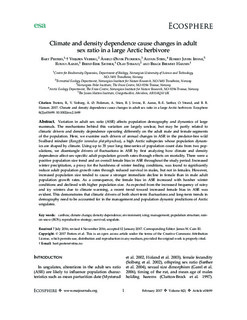Climate and density-dependence cause changes in adult sex ratio in a large Arctic herbivore
Peeters, Bart; Veiberg, Vebjørn; Pedersen, Åshild Ønvik; Stien, Audun; Irvine, Robert Justin; Aanes, Ronny; Sæther, Bernt-Erik; Strand, Olav; Hansen, Brage Bremset
Journal article, Peer reviewed

View/
Date
2017Metadata
Show full item recordCollections
- Publikasjoner fra CRIStin - NINA [2364]
- Scientific publications [1392]
Abstract
Peeters, B., V. Veiberg, A. Ø. Pedersen, A. Stien, R. J. Irvine, R. Aanes, B.-E. Sæther, O. Strand, and B. B. Hansen. 2017. Climate and density dependence cause changes in adult sex ratio in a large Arctic herbivore. Ecosphere 8(2):e01699. 10.1002/ecs2.1699
Variation in adult sex ratio (ASR) affects population demography and dynamics of large
mammals. The mechanisms behind this variation are largely unclear, but may be partly related to
climatic drivers and density dependence operating differently on the adult male and female segments
of the population. Here, we examine such drivers of annual changes in ASR in the predator-free wild
Svalbard reindeer (Rangifer tarandus platyrhynchus), a high Arctic subspecies whose population dynamics
are shaped by climate. Using up to 35 year long time-series of population count data from two populations,
we disentangle drivers of fluctuations in ASR by first analyzing how climate and density
dependence affect sex-specific adult population growth rates through effects on mortality. There were a
positive population size trend and an overall female bias in ASR throughout the study period. Increased
winter precipitation, a proxy for the harshness of winter feeding conditions, was found to significantly
reduce adult population growth rates through reduced survival in males, but not in females. However,
increased population size tended to cause a stronger immediate decline in female than in male adult
population growth rates. As a consequence, the female bias in ASR increased with harsher winter
conditions and declined with higher population size. As expected from the increased frequency of rainy
and icy winters due to climate warming, a recent trend toward increased female bias in ASR was
evident. This demonstrates that climatic drivers of both short-term fluctuations and long-term trends in
demography need to be accounted for in the management and population dynamic predictions of Arctic
ungulates.
